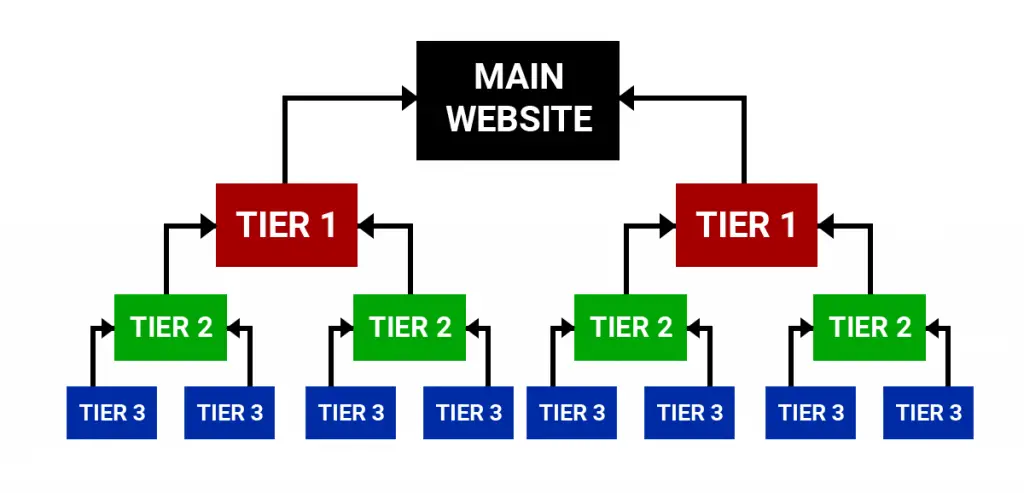In this article, you’ll learn all about tier 2 backlinks for SEO.
Not only will you understand the definition of tier 2 backlinks, but you’ll also get a set of second-tier backlink examples, an overview of why they’re important for SEO, and a list of tier 2 link building resources you can use to acquire more of these types of backlinks for your website.
The ultimate goal here is to help you understand what tier 2 backlinks are and how they fit into the overall strategy of a link pyramid system for off-page search engine optimization to help your website rank higher in the search engine results pages (SERPS).

What Are Tier 2 Backlinks?
Tier 2 backlinks are links that are built to one of the existing links to your website. Second-tier backlinks are used to increase the PageRank value of the first-tier backlinks so more link equity can be transferred to your website for SEO.
Tier 2 Backlink Examples
- Good quality web 2.0 backlinks
- Directory links
- Profile links
- Social bookmark links
- PBN backlinks
- Press release links
- Social media backlinks
Why Are Tier 2 Backlinks Important?
Tier 2 backlinks are important because they pass ranking authority to your website by boosting up existing links. Search engines crawl tier 2 backlinks to measure the importance and quality of first-tier links pointing to your site indexing and ranking purposes in the SERPs.

Overview of Tier 2 Link Building
In a tiered link building strategy, there are three tiers in the link pyramid:
- Tier 1 backlinks
- Tier 2 backlinks
- Tier 3 backlinks
Tier 2 backlinks are indirect links that transfer link equity to the main website for SEO purposes. Tier 3 backlinks point to the tier 2 links. And tier 2 backlinks point to the tier 1 links, which point to the main website. That’s why some people refer to this strategy as a link pyramid.
The main goal of tier 2 link building is to increase the page authority score for first-tier backlinks that point to your website’s homepage or individual URLs to help them rank higher in the SERPs.
Tier 2 backlinks are the second most important links in a tiered link building system because they indirectly point to your website. Second-tier links do not have a direct connection to the main website but rather point to the tier 1 backlink URLs to help increase their PageRank values for SEO.
As for the quality of tier 2 backlinks, you don’t have to be as strict as the first-tier links because they’re not directly sending link equity to your website. The goal with second-tier backlinks is to combine a mixture of quality and quantity. Anything that’s not pure spam is typically good enough for tier 2 link building.
When you’re building second-tier backlinks, you can lower the quality and relevance of those links to get more backlinks created in a shorter amount of time. It’s also good for tier 2 backlinks to be a combination of dofollow and nofollow links.
In a link pyramid that uses tiered backlinks, it’s better to focus on getting a higher quantity of decent quality tier 2 backlinks so you can build these types of links at a faster rate. However, you don’t want to lower your standards too far at the second-tier level to include spammy links. Again, quality does still matter to an extent here, so you want your tier 2 backlinks to be medium to high quality in the second stage of the link building pyramid.
Tier 2 Link Building Resources
If you want some ideas on how to build quality second-tier backlinks, then check out these resources:
Tier 2 Backlinks Summary
I hope you enjoyed this guide on tier 2 backlinks.
As you discovered, tier 2 link building is the second most important stage of a link pyramid because it contains links that indirectly point to your main website. These second-tier backlinks are used to boost up existing links to pass more link equity for SEO. Therefore, you should do everything you can to get a higher quantity of tier 2 backlinks to improve the PageRank scores for target URLs faster.

SEO Chatter is dedicated to teaching the fundamentals of search engine marketing to help marketers understand how to increase organic website traffic and improve search engine rankings.
